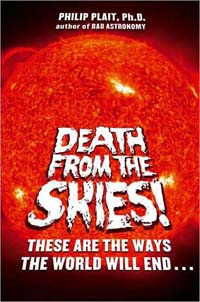Hooray! Phil’s long awaited follow-up book to Bad Astronomy hit the shelves last Fall; he doesn’t like to be addressed as doctor. He told everyone last year at the Iron Cactus get-together about it and I bought this at Book People as soon as I spotted it at a chain.
First I have to explain that the title is misleading. It’s not a doom-n-gloom book which is the last thing the world needs in these ugly, uncertain times. DFtS is a reassuring, matter-of-factly, well-written assessment on how the human race has beaten some staggering odds because the Universe is pretty hostile. Actually, many of the dangers are highly improbable in most people’s lifetimes but he makes them fascinating while dispelling several myths purported by science classes, the media and popular assumptions.
Each chapter begins with the disaster’s description like it were written for a novel. Sadly, they end in doom, except for one: galactic collisions which occur at speeds that even glaciers outrace. Phil also writes about the events in order of likelihood and if humans can do anything to prevent their dire outcomes. Only one can be stopped; an asteroid or comet impact; and another can be worked around; a solar flare. The remaining possibilities are fatal: a nearby star going supernova, a gamma-ray burst, a black hole, an alien attack (if they’re hostile to all life), the death of our sun, galaxies colliding and entropy. Not like the human race has any means to combat them now. Again, it seems morbid yet if you read on, especially to the end, there’s a table showing how infinitesimal the odds are. Getting bit by a shark, hit by lightning or winning a major lottery are more likely than the earth being sterilized from a gamma-ray burst.
I’m not sure if his real goal was to dispel the irrational anxiety I had as a kid after seeing The Black Hole or to give me a better understanding of Hawking, the Big Bang and how the Universe really works. Probably both since you can’t have one without the other. Either way, I enjoyed every page because Hawking’s theories/work are mind boggling (I needed it dumbed down) and he did it without me requiring to relearn all the complicated math I’ve forgotten over 20 years. This book should be mandatory with Bad Astronomy in all diehard high school Astronomy classes and all college-level courses, especially if it finally dispels the old belief of the Earth being swallowed up by the Sun in a few billion years.


Pingback: Dr. Phil Plait